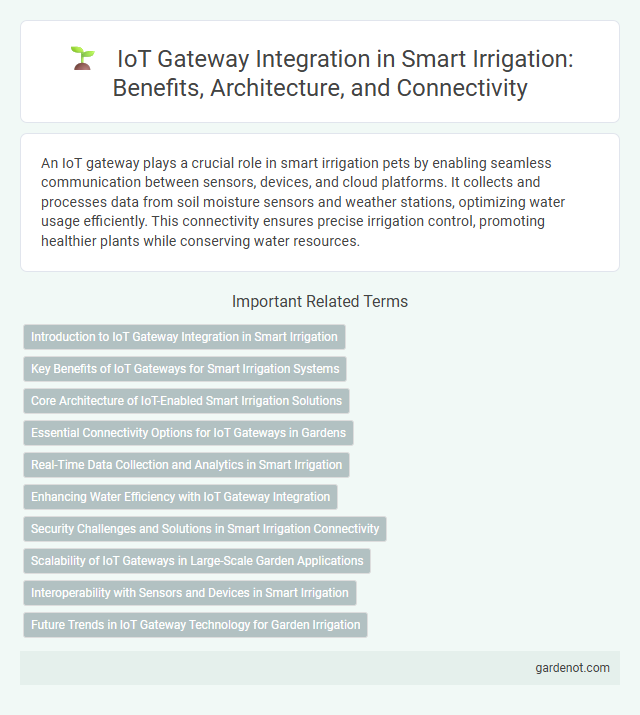An IoT gateway plays a crucial role in smart irrigation pets by enabling seamless communication between sensors, devices, and cloud platforms. It collects and processes data from soil moisture sensors and weather stations, optimizing water usage efficiently. This connectivity ensures precise irrigation control, promoting healthier plants while conserving water resources.
Introduction to IoT Gateway Integration in Smart Irrigation
IoT gateway integration in smart irrigation enables seamless communication between soil sensors, weather stations, and cloud-based analytics platforms, optimizing water usage and crop health. These gateways process data at the network edge, ensuring real-time decision-making and reducing latency in irrigation control systems. Efficient IoT gateway deployment enhances scalability and interoperability across diverse agricultural environments by supporting multiple communication protocols such as LoRaWAN, Zigbee, and NB-IoT.
Key Benefits of IoT Gateways for Smart Irrigation Systems
IoT gateways enable real-time data processing and seamless communication between soil sensors, weather stations, and irrigation controllers in smart irrigation systems. They enhance water efficiency by allowing precise control of watering schedules based on moisture levels and environmental conditions. By integrating multiple devices, IoT gateways reduce data latency and improve system reliability, leading to optimized resource management and lower operational costs.
Core Architecture of IoT-Enabled Smart Irrigation Solutions
The core architecture of IoT-enabled smart irrigation solutions revolves around the IoT gateway, which acts as the central hub connecting soil moisture sensors, weather stations, and water supply systems to the cloud platform. This gateway ensures real-time data aggregation, edge computing, and seamless communication between field devices and remote servers, enabling precise irrigation scheduling and water resource management. Robust protocols such as MQTT and CoAP optimize data transmission efficiency, while security features safeguard sensitive agricultural data.
Essential Connectivity Options for IoT Gateways in Gardens
IoT gateways in smart irrigation systems require robust connectivity options such as Wi-Fi, LoRaWAN, and Zigbee to efficiently manage sensor data and control irrigation devices across garden areas. These protocols enable reliable long-range communication with low power consumption, crucial for maintaining real-time soil moisture monitoring and automated watering schedules. Cellular connections can also be integrated to ensure remote access and system management regardless of local network availability.
Real-Time Data Collection and Analytics in Smart Irrigation
IoT gateways enable real-time data collection and analytics in smart irrigation by aggregating sensor data such as soil moisture, temperature, and weather conditions. These gateways process data locally to provide instant insights and trigger automated irrigation adjustments, optimizing water usage and crop health. Integrating edge computing capabilities reduces latency and enhances decision-making accuracy for precise water management.
Enhancing Water Efficiency with IoT Gateway Integration
IoT gateway integration in smart irrigation systems enables real-time data collection from soil moisture sensors and weather stations, optimizing water usage by precisely targeting irrigation needs. By processing and transmitting sensor data to centralized platforms, IoT gateways facilitate automated irrigation schedules that reduce water wastage while maintaining crop health. Enhanced connectivity and edge computing capabilities within IoT gateways support adaptive watering strategies, significantly improving overall water efficiency in agricultural operations.
Security Challenges and Solutions in Smart Irrigation Connectivity
IoT gateways in smart irrigation face significant security challenges, including unauthorized access, data breaches, and network vulnerabilities that can compromise system integrity and crop health. Implementing robust encryption protocols, multi-factor authentication, and regular firmware updates enhances protection against cyber threats while ensuring secure, reliable communication between sensors and cloud platforms. Employing edge computing within gateways also minimizes data transmission risks and enables real-time threat detection, optimizing both security and operational efficiency in smart irrigation networks.
Scalability of IoT Gateways in Large-Scale Garden Applications
IoT gateways in smart irrigation systems enable seamless management of extensive sensor networks across large-scale gardens, ensuring efficient data aggregation and real-time monitoring. Their scalable architecture supports the integration of thousands of soil moisture sensors and weather stations, optimizing water usage and enhancing crop health. High-capacity gateways facilitate robust connectivity and data processing, crucial for expanding garden applications without compromising system performance.
Interoperability with Sensors and Devices in Smart Irrigation
IoT gateways in smart irrigation enable seamless interoperability by bridging diverse sensors and devices through standardized communication protocols like MQTT, CoAP, and Zigbee. These gateways aggregate data from soil moisture sensors, weather stations, and valve actuators, ensuring real-time monitoring and precise control of irrigation systems. Enhanced interoperability reduces integration complexity, promotes scalable networks, and optimizes water usage efficiency across agricultural landscapes.
Future Trends in IoT Gateway Technology for Garden Irrigation
IoT gateways for garden irrigation are evolving with enhanced edge computing capabilities, enabling real-time data processing and faster decision-making on water usage. Integration of AI-driven analytics within these gateways allows precise soil moisture monitoring and adaptive irrigation scheduling, reducing water waste significantly. Future trends also include advanced interoperability standards, facilitating seamless connectivity between diverse sensors, controllers, and cloud platforms for smarter, scalable irrigation systems.
IoT gateway Infographic

 gardenot.com
gardenot.com